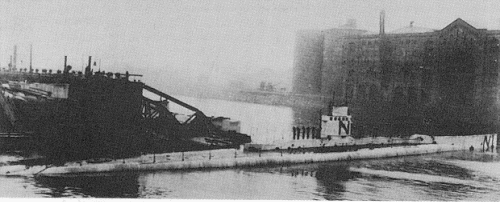
NAVYPEDIA
 Support the project with paypal
Support the project with paypal
Photo

Nautilus 1917
Ships
| Name | No | Yard No | Builder | Laid down | Launched | Comp | Fate |
|---|---|---|---|---|---|---|---|
| N1 (ex-Nautilus) | IAC, 20 | Vickers, Barrow | 3/1913 | 31.12.1914 | 10/1917 | sold 6.1922 |
Technical data
| Displacement standard, t | |
|---|---|
| Displacement normal, t | 1441 / 2026 |
| Length, m | 78.8 |
| Breadth, m | 7.92 |
| Draught, m | 5.41 |
| No of shafts | 2 |
| Machinery | 2 12-cyl Vickers diesels / 2 electric motors |
| Power, h. p. | 3700 / 1000 |
| Max speed, kts | 17 / 10 |
| Fuel, t | diesel oil |
| Endurance, nm(kts) | 5300(11) / 72(3) |
| Armament | 1 x 1 - 76/30 10cwt QF Mk I, 8 - 450 TT (2 bow, 4 beam, 2 stern, 16) |
| Complement | 42 |
| Diving depth operational, m | 30 |
Graphics
Project history
In reply to the 1912 Submarine Committee's recommendation that an overseas submarine be built, displacing 1000t and capable of 20kts on the surface, Vickers produced a design. Unfortunately their conclusion was that 17kts was the maximum to be hoped for, while displacement would be at least 1270t. The Admiralty was disappointed at this pessimistic view, but realized that Vickers had far more experience with diesels than any other builder, and even that experience was limited to four years' running with A13 and three years with D1. The FIAT company, when approached through Scott's, agreed with Vickers and were most reluctant to guarantee even the 1850bhp proposed by Vickers for their new 12-cyl diesel. They suggested instead a steam turbine installation, which was rejected but used subsequently in Swordfish. Vickers were given a provisional order in October 1912 (covering design work)and laid the keel in March 1913, a month before the official order was received. As predicted development of the big diesel proved very slow, particularly under wartime conditions, and although she was launched at the end of 1914 she was not completed until October 1917 (having been numbered N1 in June). Although nominally in service with the 6th Flotilla at Portsmouth she never became operational and was used as a depot ship, supplying power to other submarines. This apparent failure conceals the fact that she was a giant step forward, not only in size but in power. The experience provided useful data for future developments.
Modernizations
None.
Naval service
Submarine was never actually operational and served mostly as a depot ship and recharging plant.
 HOME
HOME FIGHTING SHIPS OF THE WORLD
FIGHTING SHIPS OF THE WORLD UNITED KINGDOM
UNITED KINGDOM SUBMARINES
SUBMARINES N1 submarine (1, 1917)
N1 submarine (1, 1917)
